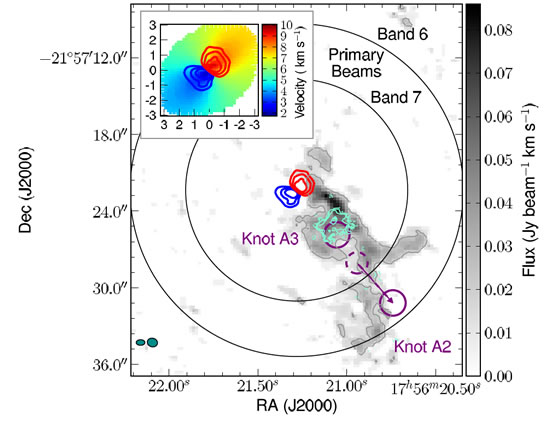Research Gallery > Atacama Large Millimeter/submillimeter Array (ALMA)
Research Gallery
Atacama Large Millimeter/submillimeter Array (ALMA)
| ALMA detection of the rotating molecular disk wind from the young star HD 163296 |
|
Image Credit: Pamela Klaassen

Blue shifted disk wind from HD 163296.
The grey-scale shows the CO J=2-1 integrated intensity of the blue shifted wind from HD 163296. The 4σ level is indicated by the grey contour. The blue and red contours show the 15, 20 and 25 times the rms noise of the blue and red HCO+ J=4-3 emission in the disk. The inset image shows the first moment map of the HCO+ J=4-3 emission in the disk, with the same red and blue contours. The two black arcs show the primary beams of the 345 GHz (smaller) and 230 GHz (larger) observations. The cyan contours show 4, 6, and 8 times the rms noise in the CO J=3-2 emission. The two solid purple circles show the expected positions of Herbig Haro knots A2 and A3 in 2012. The dashed purple circle and arrow show the position of knot A2 in 2004, and its projected motion to 2012. The two dark cyan circles in the bottom left corner show the synthesized beams of the 345GHz (left) and 230 GHZ (right) datasets.
|
| ASIAA researchers S. Takahashi and E. Chapillon joined an international team led by P. Klaassen from Leiden Observatory to study the molecular wind from the young star HD 163296 thanks to ALMA Science Verification data.
Beside the CO emission associated with the protoplanetary disks surrounding HD 163296, ALMA data reveals an additional emission feature seen both in CO J=2-1 and CO J=3-2, and offset by -18.6 km/s from the disk emission. The emission has a double corkscrew morphology and extends more than 10′′ from the disk with embedded emission clumps coincident with the chain of Herbig Haro knots previously detected in the visible domain. We interpret this double corkscrew
as emission from material in a molecular disk wind, and that the compact emission near the jet knots is being heated by the jet which is moving at much higher velocities. Excitation analysis suggests temperatures exceeding 900 K in these compact features, with the wind mass, momentum and energy being of order 10$^{−5} M${_\odot}$, 10$^{−4}{_\odot}$km s$^{−1}$ and 10$^{40}$ erg respectively. The high mass loss rate suggests that this star is dispersing the disk faster than it is funneling mass onto the star.
This study is published in Astronomy and Astrophysics (Klaassen et al 2013 A&A, 555A, 73K) |
 asiaa.sinica.edu.tw Media Request: epo
asiaa.sinica.edu.tw Media Request: epo asiaa.sinica.edu.tw
asiaa.sinica.edu.tw 
